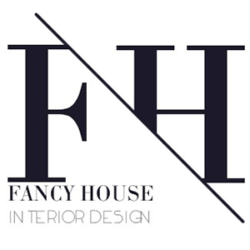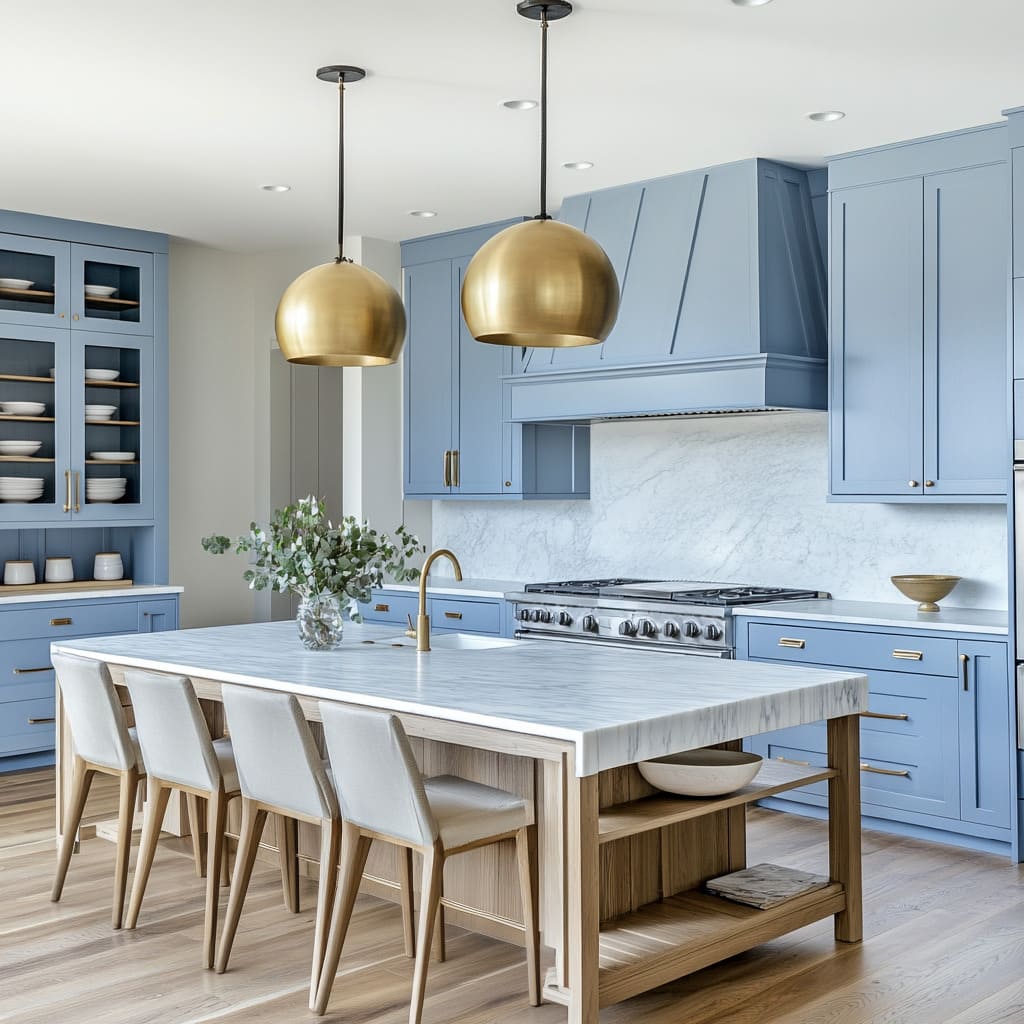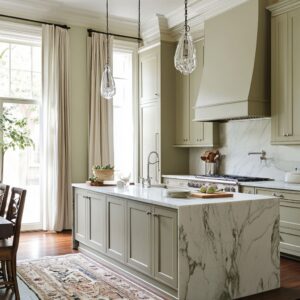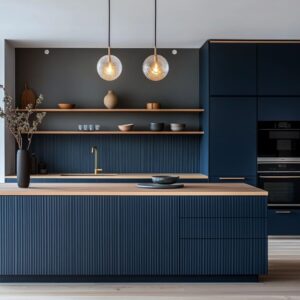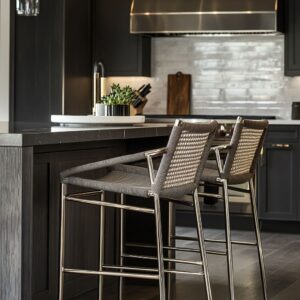Blue farmhouse kitchens have taken a clear lead in how designers blend classic comfort with a fresher point of view. These spaces don’t follow a single formula—they stretch from quiet and powdery tones to deep, moody blues, each used in a way that supports how the kitchen works, looks, and feels over time.
Across different layouts, you’ll find recurring details like wood beams, open shelves, apron sinks, and handmade finishes, but how these pieces are used shifts depending on light, materials, and local inspiration.
What makes these kitchens stand out isn’t one feature—it’s the way everything connects. The color of the cabinets ties into the finish on the hardware.
The lighting highlights the grain of the wood. The stone counters are chosen not just for durability but for the way they interact with light and texture.
This article takes a close look at some standout examples and breaks down the subtle choices that shape how modern farmhouse kitchens come together—especially those working with the full range of blues. From layout decisions to material contrasts, every detail plays a role in how these kitchens function and how they feel.
Subtle Shifts in Blue Tones
You’d think “blue cabinets” would mean one thing, but in farmhouse kitchens, the color behaves more like a living surface than a fixed hue. A single space might look completely different in the morning compared to late afternoon, especially if it’s flooded with natural light.
That’s because designers often pick paint formulas with undertones of green or gray, allowing the cabinetry to shift tone depending on how sunlight enters the room. In kitchens with skylights or oversized windows, you’ll often catch the cabinets pulling a hint of slate, seafoam, or even smoke—without changing a thing.
These shifts aren’t accidental. In fact, muted finishes—especially matte or eggshell paints—are often chosen precisely because they don’t reflect much light.
That quality helps them pick up environmental tones, like the green of a nearby tree outside or the soft beige of limestone flooring. That’s part of what gives farmhouse blue kitchen cabinets their depth—they stay grounded, but never flat.
There’s also a noticeable contrast in how blue is used to create different moods. In kitchens that go bold, you’ll see deep navy or classic cobalt paired with white marble counters or brushed brass lighting.
This contrast draws your eye instantly and gives the space a structured, more formal energy. But in homes leaning into the relaxed country aesthetic, you’ll often find powdery or cornflower blue combined with wood counters, linen-colored walls, or cream tile.
The softer balance works well in homes styled after country blue kitchen cabinets often found in farmhouse designs inspired by coastal or inland American traditions. This range of tones gives homeowners flexibility.
The exact shade of blue can serve either as a bold feature or a subtle backdrop—depending on how it’s framed by natural light, flooring materials, and surrounding decor.
Material Pairings That Go Beyond the Usual
What separates a basic kitchen from one that leaves a lasting impression is how its surfaces talk to each other. In farmhouse kitchens, stone plays a major role—but not always in obvious ways.
Instead of the glossy, polished slabs you might expect, there’s a clear preference for honed or matte finishes. These quieter surfaces reduce glare and allow other textures—like brushed brass or reclaimed wood—to stand out.
Some designers even use bookmatched stone treatments in corners or backsplashes, letting the natural veining form a mirrored pattern that feels quietly intentional rather than flashy.
Flooring gets a thoughtful approach too. Instead of defaulting to oak planks, you’ll see marble tiles in herringbone or checkerboard layouts, and even limestone-style floors in warm tones that contrast softly with cooler cabinet colors.
These combinations help temper the mood: even when a kitchen leans toward polished finishes, the overall effect feels approachable.
Wood and metal layers are another place where modern farmhouse kitchens do things differently. It’s not all matching brass hardware and subway tile anymore.
There’s often a mix—brushed nickel faucets with black iron stools, or copper lighting above open pine shelves. Reclaimed beams, often rough and cracked, frame the kitchen like a structural border, while thick floating shelves in live-edge wood create a softer break between stone and wall.
These layers add rhythm and a natural sense of weight without overwhelming the space.
Hardware styles aren’t left to chance either. You’ll find a mix of cup pulls, slim bar handles, and mushroom knobs all within the same kitchen—but used with purpose.
Deep drawers often carry horizontal pulls for grip and symmetry, while narrow cabinets get petite knobs or latches. On taller pantry doors, vertical pulls give the illusion of added height.
This variety keeps the kitchen visually interesting while giving each cabinet and drawer its own function-forward detail. Together, these textures and finishes do more than decorate—they ground the space, create subtle contrast, and invite touch.
This attention to how materials feel, not just how they look, is part of what makes today’s farmhouse kitchens more layered and lasting.
Lighting as a Design Signature
Lighting does more than illuminate—it’s a style marker, and in modern farmhouse kitchens, it often becomes one of the most defining features. Whether you’re standing under a pair of oversized dome pendants or catching the glow from under-cabinet lights, the way a kitchen is lit changes how it feels and functions.
Over kitchen islands, pendants are a favorite—and not just any pendants. Wide dome shapes in brushed brass or hand-rubbed copper bring a sculptural layer to the space.
The choice of interior finish—whether it’s a soft white or a gold-toned inner surface—can shift the light from crisp to warm, depending on the mood you’re going for. In homes inspired by coastal or rustic influences, these fixtures are often chosen to mirror other materials nearby, like aged hardware or natural wood accents.
At the opposite end of the spectrum, minimalist lighting takes a more subtle route. Thin cords with barely-there fixtures hang from high ceilings, offering light without blocking the view of architectural features.
These work especially well in kitchens with vaulted or plank-lined ceilings, where the lighting acts as a complement rather than a focal point. Then there’s the lighting you don’t immediately notice—under-cabinet strips, shelf-integrated LEDs, and softly lit pantries.
These are more than convenience features. They highlight texture in tile and stone, make early-morning prep easier, and in some kitchens, they even act like display lighting.
In spaces with open shelving, a bit of under-shelf glow brings attention to everyday objects in a way that feels inviting and clean.
Ceiling treatments add another layer. Beadboard and wide wood planks are often used across ceilings in a rustic blue farmhouse kitchen, but what’s interesting is how designers tuck lighting within beams or angle it along the pitch of the ceiling.
Track lights, spot fixtures, or even recessed strips quietly work in the background, blending warm farmhouse features with modern performance.
Cabinet Door Styles and Frame Details
Cabinet details carry a lot of weight in farmhouse kitchens, even if you don’t notice them at first glance. Some styles feel traditional and built-in, while others lean more current and polished—how the doors are constructed makes a big difference.
Inset cabinets are a hallmark of older farmhouse design. Doors sit flush within the frame, showing off the craftsmanship with clean reveals and solid framing.
This style is often paired with deep drawer fronts, visible wood grain, or aged paint finishes, offering a subtle nod to heritage furniture. Many of the most compelling blue farmhouse kitchen ideas use this approach because it pairs so naturally with brass hardware, wood counters, and classic farmhouse sinks.
Full-overlay cabinetry takes a more modern route. With doors that cover the full face of the box, it creates a smoother overall look.
This style usually features thin shaker profiles or completely flat fronts, letting materials like soft matte paint or brushed hardware stand out. It’s a popular pick in homes that want the farmhouse warmth but with a more updated layout.
Upper cabinets sometimes feature glass inserts to lighten the visual mass, especially when darker paint is used below. Glass-front doors can also help open up the space in a subtle way.
For kitchens with higher storage needs, the inclusion of transoms or mullion-style fronts—especially X-shaped or arched mullions—gives visual rhythm while still serving function. These are small architectural cues that keep the cabinetry from feeling too flat or generic.
Altogether, these cabinetry choices shape how farmhouse kitchens look and feel. Whether you’re working with traditional wood joinery or modern flush panels, the framing and finishes are what connect all the elements—making the space feel balanced and built with care.
Emphasis on Symmetry and Proportion
In the best farmhouse kitchens, balance doesn’t shout—it whispers. One of the clearest signs of this is the way elements are placed.
Designers often build the layout around symmetry, anchoring key components like the range, windows, or sink, and flanking them with cabinets, shelves, or lighting in mirrored pairs. It’s not about formality—it’s about calm.
A perfectly centered hood between glass-front cabinets or evenly spaced pendants over an island instantly makes the space feel grounded.
Even in kitchens with a more casual rhythm, there’s still a quiet discipline. Open shelving is carefully spaced, objects are grouped with intention, and visual weight is distributed evenly across the room.
These small decisions add up. They keep the eye moving without distraction and create a subtle sense of order, even in rooms meant for messy creativity.
This approach is especially clear in a modern farmhouse blue kitchen, where strong colors and textures benefit from thoughtful arrangement. Without symmetry, bold tones or standout materials can easily feel overpowering.
But when everything lines up—cabinets to ceiling, island to hood—the whole space feels pulled together in a way that doesn’t demand attention, but earns it.
Personalization and Decorative Restraint
One of the most defining traits of farmhouse kitchens—especially the newer interpretations—is how restrained they are in terms of decoration. You won’t find cluttered shelves or trendy styling tricks.
Instead, what you’ll usually notice are a few useful objects left out in plain view. Things like a stone crock filled with wooden spoons, a line of labeled jars for flour and sugar, or a single pot of basil on the windowsill.
These aren’t props—they’re part of daily life, chosen for their utility, but displayed with quiet intention.
This approach gives the kitchen a natural rhythm. It feels lived in, not staged.
It also makes personalization feel effortless—every bowl, utensil, or basket carries its own small purpose. Even the furniture speaks to this.
Look under an island and you might see a pair of corbels or carved feet that echo vintage farmhouse tables. Or a turned leg in the corner that hints at heirloom furniture without getting too ornate.
These small touches help bridge the gap between past and present. The restraint here is what keeps things timeless.
With a few thoughtful accents and one or two furniture-inspired details, a farmhouse kitchen can feel unique without being overly decorated or fussy. It’s a style that feels honest—one where the charm comes from how things are used, not how much is added.
Mixing Tactile Textures
Texture brings a kind of quiet richness to farmhouse kitchens—especially the ones leaning into deeper tones. In a dark blue farmhouse kitchen, matte finishes play a central role.
These soft, low-sheen surfaces pull light in rather than bounce it back, creating a subtle depth that pairs beautifully with materials like honed stone, unfinished wood, or brushed hardware.
The contrast between matte and gloss is one of the most effective tricks in the toolbox. Glossy tiles, used sparingly on a backsplash or around a sink, can catch morning light and add just the right amount of shimmer to break up a muted space.
It’s not about flash—it’s about movement and balance.
Another pairing that shows up again and again is the mix of polished and raw. Smooth cabinetry and sleek appliances are often set against rugged elements like aged brick, plaster walls, or limestone tile.
These rougher textures act as grounding points. They keep the kitchen from looking too clean or too uniform, and they work especially well with natural wood accents or open shelving.
The interplay between refined and rustic gives the room a lived-in feeling—layered without being overdone. Even small touches—like a hammered metal light fixture or hand-thrown ceramic bowl—add to this idea of contrast.
It’s less about perfection and more about materials that feel honest and welcoming to the touch.
Advanced Storage and Utility
In modern farmhouse kitchens, storage is more than a necessity—it’s part of the overall experience. You’ll find features that work hard but stay out of sight, helping the kitchen stay clear and calm without losing function.
One example is the slim pull-out tucked beside the range. It might look like a narrow panel, but behind it, there’s a rack built just for oils, spices, or utensils.
These make cooking smoother without cluttering the countertop. Appliance garages—those lift-up or slide-back cabinets—are another favorite, often positioned near the corner or on the counter’s back edge to keep toasters and mixers ready to use but hidden when they’re not needed.
Deep drawers are now standard in many farmhouse layouts, replacing the older base cabinets with doors. These wide drawers glide out smoothly and hold everything from cookware to mixing bowls.
It’s not just about capacity—it’s about seeing everything at a glance, so nothing gets lost at the back.
Pantries have also evolved. Some are full-height built-ins with barn-style doors that slide open to reveal perfectly lined shelves and labeled jars.
Others are walk-in or corner pantries hidden behind framed millwork, blending seamlessly into the cabinetry. In more open kitchens, some pantry sections are designed with glass fronts or open shelves, turning ordinary storage into a visual detail.
This level of practicality means the kitchen doesn’t have to trade charm for convenience—it keeps both. And it’s one of the reasons farmhouse kitchens continue to feel relevant.
They offer comfort and good looks without letting function fall behind.
Concluding Observations
Across all these kitchens, one thing is clear: the charm of farmhouse style hasn’t faded—it’s just gotten smarter. What used to be rustic for the sake of tradition now blends comfortably with cleaner lines and practical choices.
Exposed beams, apron sinks, and open shelves still have their place, but they’re joined by things like concealed lighting, smart storage solutions, and subtle color shifts that change throughout the day.
The wide range of blue tones—from barely-there greys to deep Prussian blues—proves how much impact color can have on the overall mood. A dusty slate blue might feel relaxed and understated in one home, while a strong, inky shade might bring weight and formality to another.
This versatility is part of what keeps farmhouse kitchens from falling into a formula—they feel personal.
What really ties everything together is the way materials are layered. Smooth stone meets grainy wood.
Aged brass hardware rests on painted cabinetry. Modern appliances sit below old-style vent hoods.
This mix doesn’t feel forced—it works because the contrast is handled with care. That’s what gives these kitchens their long-lasting appeal.
They offer warmth without excess, function without coldness, and style without shouting. It’s a mix that continues to inspire, from quiet country homes to updated suburban spaces.
